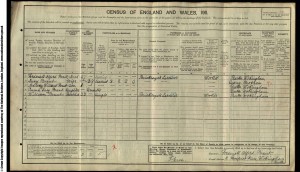Frederick Brant. Died 5 Dec 1917
Frederick is one of five Brants who are named on Wokingham Remembers. Although the Brant name is first mentioned in the Wokingham area in the 1600’s, this branch is from Sherfield in Hampshire. It was Frederick’s father Alfred, who moved to Wokingham from Sherfield after meeting and in 1873, marrying a local girl, Elizabeth Frankham. Alfred and Elizabeth would not live to see the appalling loss the family suffered in the First World War and even before.
Frederick Alfred Brant was born in 1883 and was sixth of nine children, five boys and four girls. By 1901 Frederick was a blacksmith and living with his mother in Nine Mile Lane in Crowthorne. His father had already passed away over ten years earlier when Frederick was a young boy.
By 1911, Frederick had married Lucy Rose and was living with their two children, Harvey and Emma at 8 Prospect Place, Wokingham. His single brother William was living with them and they had both found work as bricklayer’s labourers. Having lost his father as a young boy, he was also to see his mother die quite early, in 1907 and his brother handicapped brother, Henry a year later. In the year before his own death, he was to witness the loss of another brother, Charles Joshua (named on this site).
Frederick joined the Royal Berkshire 1st Battalion, but although this was a regular (pre war) unit, it is possible he was part of the reinforcements used to rebuild it following previous heavy losses. He is buried at Grevilliers, which at the time was a clearing station for casualties. This indicates that he was wounded before 5th December 1917, the day he died. If this is the case he may have been mortally wounded during fighting at Bourlon Wood, just to the west of Cambrai. He may even have been wounded during the Battle of Cambrai the previous month. The 1st Battalion was involved in the fighting around this area at the time. In a sense the exact point at which Frederick died was not as important as his involvement in the defence of Cambrai. It was highly successful and led Sir Douglas Haig to state:
“I congratulate you and the Officers and men under your command upon the successful resistance maintained by the Third Army yesterday against the powerful attacks delivered by the enemy South and West of Cambrai. In particular I desire you to convey to the General Officers commanding the 2nd, 47th and 56th Divisions, and to all ranks serving under them, my warm appreciation of their magnificent defence of the important positions entrusted to them. Though exposed throughout the day to the repeated assaults of superior forces, they beat off all attacks with the heaviest losses to the enemy, and, by their gallant and steady conduct, contributed very largely to the security of the Divisions engaged on the whole front of attack.”
BRANT, F A
Rank: Private
Service No:27172
Date of Death: 05/12/1917
Regiment/Service: Royal Berkshire Regiment 1st Bn.
Grave Reference IX. C. 14.
Cemetery GREVILLERS BRITISH CEMETERY
The village of Grevillers was occupied by Commonwealth troops on 14 March 1917 and in April and May, the 3rd, 29th and 3rd Australian Casualty Clearing Stations were posted nearby. They began the cemetery and continued to use it until March 1918, when Grevillers was lost to the German during their great advance. On the following 24 August, the New Zealand Division recaptured Grevillers and in September, the 34th, 49th and 56th Casualty Clearing Stations came to the village and used the cemetery again. After the Armistice, 200 graves were brought in from the battlefields to the south of the village, 40 from an adjoining cemetery made during the German occupation.
Honey Hill 1901
Nine Mile Lane, Crowthorne, Berkshire 1891
8 Prospect Place, Wokingham, 1911

